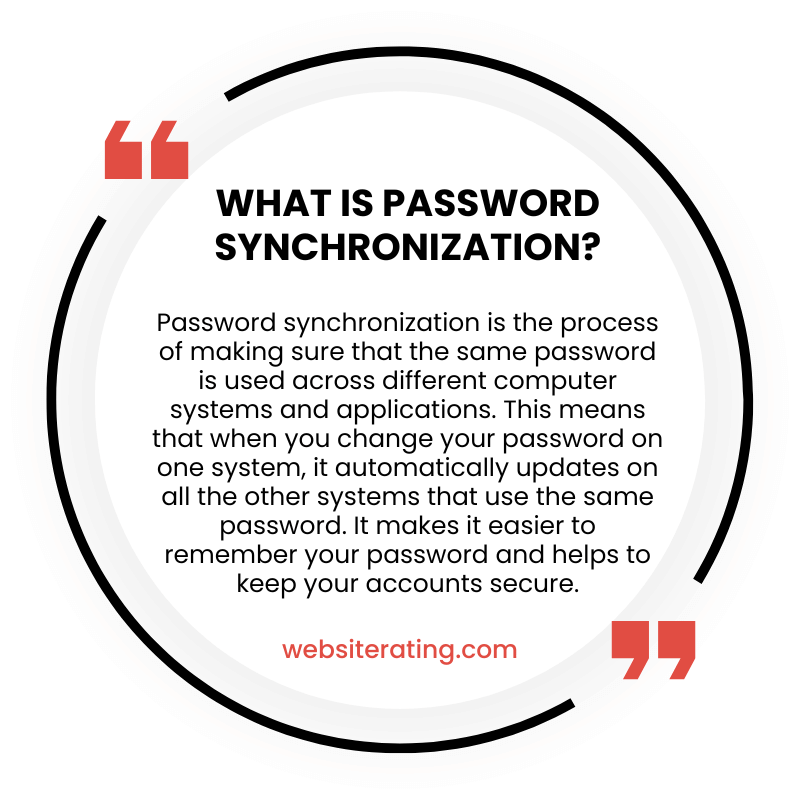Password synchronization, also known as password syncing, is a process that allows users to store and access different passwords on multiple devices. This process provides the convenience of having multiple passwords without having to remember them all.

It is especially useful for people who use multiple devices or have several online accounts. By synchronizing passwords across devices, users can quickly sign in to their accounts from any device with just one password.
In addition, it eliminates the need for manually entering the same information each time they log in, which can be time-consuming and tedious. The purpose of this article is to explain what password synchronization is and provide practical examples for beginners to help understand how it works.
What is Password Synchronization?
The concept of synchronization as it relates to password security is explored in this section.
Password synchronization is the process of keeping all user passwords up-to-date across multiple platforms and devices. It involves linking a user’s accounts on different websites, services, and applications with a single master password that will be used to access them.
This allows users to easily access their information from any device while ensuring that their data remains secure by using strong encryption techniques. Synchronization also helps users keep track of all their online accounts by making it easier to remember passwords for each one as they only have to remember one master password.
In practical terms, this means that when a user changes or updates their master password on one service or platform, the same change will automatically occur on all other synchronized accounts without requiring additional efforts from the user. This helps reduce the risk of hackers gaining access to multiple accounts by using stolen credentials due to human error or weak passwords.
Additionally, password synchronization can help protect against phishing attacks since it eliminates the need for users to type in long passwords manually into websites or apps they are unfamiliar with which could potentially be malicious sites set up by hackers.
Advantages of Password Synchronization
Through synchronization of credentials, users can experience the convenience and security benefits of a unified access system. Password synchronization is a feature that allows multiple accounts to be linked together, allowing them to share the same password across different platforms and devices. This facilitates easy access for users without the need to remember separate passwords for each account. Additionally, it also reduces the risk of malicious actors gaining access to multiple accounts through one compromised credential.
Furthermore, password synchronization is beneficial from an administrative perspective as it eliminates the need for manual user management processes such as resetting passwords or adding new users. It also reduces IT overhead costs associated with managing multiple user accounts in various systems or applications. The automation process simplifies tasks while providing secure authentication and authorization capabilities across all systems used by an organization or individual user.
Practical Examples for Beginners
For those new to the concept, practical examples of password synchronization can provide a helpful starting point for understanding its capabilities and use-cases.
Password synchronization is used in many popular online services such as Gmail, Dropbox, and Slack.
For example, with Gmail one can log into their account from any device by using the same username and password combination. The user’s credentials are stored on Google’s servers and synchronized across multiple devices so they don’t have to remember multiple usernames or passwords. This makes it easier to access websites that require authentication while ensuring data security.
Another useful example is a cloud storage service like Dropbox. This service also uses password synchronization to securely store user data on its servers while providing users with the ability to access their data from anywhere with an internet connection using just one username and password combination. By synchronizing the user’s credentials across all of their devices, this allows them to easily access all of their files without having to manually enter in a username or password each time they want to log in.
In both these cases, password synchronization provides increased security for users since only they have access to their accounts; however, it also offers convenience since there is no need for users to memorize or keep track of multiple usernames or passwords.
Summary
Password synchronization is a secure and efficient way of managing passwords across multiple devices. It allows users to have the same set of login credentials on all their devices, enabling them to access their accounts with ease.
By taking advantage of this technology, users can enjoy greater convenience and security while eliminating the hassle of memorizing multiple passwords or writing them down. Password synchronization also helps protect user data from potential breaches due to weak passwords or unauthorized access.
With its numerous benefits, password synchronization is an essential tool for any digital user looking to make their life easier and safer.
More reading
Password synchronization is a process through which a user maintains a single password across multiple IT systems. This is usually supported by software such as password managers. (source: Wikipedia)
